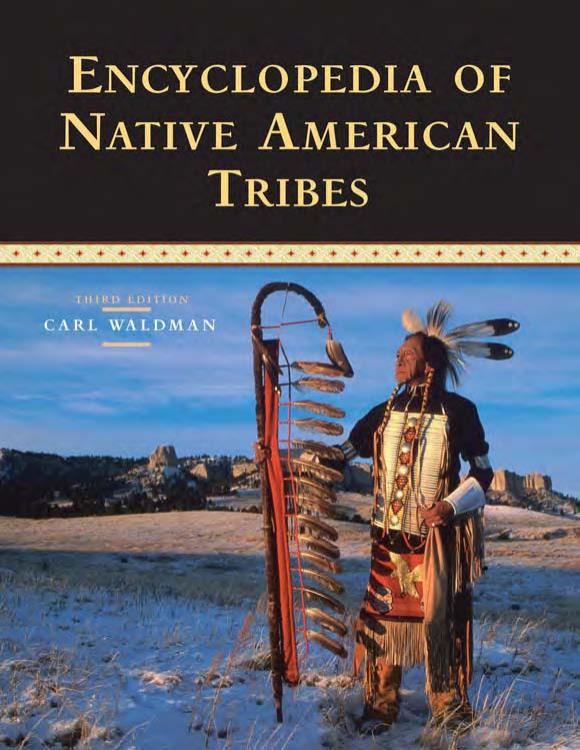Encyclopedia of Native American Tribes by Waldman Carl

Author:Waldman, Carl [Waldman, Carl]
Language: eng
Format: epub, azw3, pdf
Published: 2015-09-24T04:00:00+00:00
MOUND BUILDERS
In the eastern part of North America, especially along the Ohio and Mississippi River valleys, there are thousands of mounds not formed by geological processes. Although it was realized long ago that these earthworks, many of them enormous and some in the shape of animals, were human-made, it was not known who the makers were. Archaeologists of this century and the last have since provided the answers. It is now known that the Mound Builders were PREHISTORIC INDIANS whose cultures lasted many centuries. The Mound Builders have been classified as four different cultural groups: Poverty Point, Adena, Hopewell, and Mississippian.
The various Mound Builders lived during the phase of North American prehistory known as the Formative period, which followed the Paleolithic and Archaic periods. The Formative period lasted from about 1000 B .C . until A .D . 1500 and was characterized by farming, house building, village life, pottery, weaving, plus other advances in technology. Along with peoples of the SOUTHWEST CULTURES , the Mound Builders had the most complex and organized way of life of all the Indians north of Mexico during this period. Some of their villages expanded into actual cities.
Poverty Point Culture The Poverty Point site near present-day Floyd in northern Louisiana represents the earliest evidence of mound building. Flourishing at an early stage—the various mounds constructed between 1800 to 500 B .C ., and apparently by a nonagricultural people (although some scholars theorize a certain amount of farming among them)—Poverty Point can be called a transitional culture between Archaic Indians and Formative Indians.
The largest mound at Poverty Point—70 feet high and 710 by 640 feet wide—resembles a bird with outspread wings and was probably built for a ceremonial purpose. The site has five smaller conical mounds, four to 21 feet high, plus six concentric earthen ridges, the outermost with a diameter of two-thirds of a mile. Unlike later Mound Builders, Poverty Point Indians did not use any of their mounds for burials. The ridges are known to have held structures.
Poverty Point artifacts include finely crafted stone beads and pendants, clay figurines, and flint tools. The presence of copper, lead, and soapstone artifacts indicate widespread trade contacts.
More than 100 Poverty Point sites have been located in Louisiana, Arkansas, and Mississippi, with other sites in Tennessee, Missouri, and Florida also showing Poverty Point influences. Whether Poverty Point peoples migrated northward and helped create the next great mound building culture, the Adena culture, is not known.
Adena Culture The Adena culture lasted from approximately 1000 B .C . to A .D . 200. The name Adena, pronounced uh-DEEnuh, comes from an estate near Chillicothe, Ohio, where a large mound stands. The peoples of the Adena culture also built mounds in territory that is now Kentucky, West Virginia, Indiana, Pennsylvania, and New York, primarily along the Ohio valley.
Most of the Adena earthworks were burial mounds. Earthen hillocks were built up over burial pits or loglined tombs. To make these imposing mounds in honor of their deceased leaders, the Indians dug up
Download
Encyclopedia of Native American Tribes by Waldman Carl.azw3
Encyclopedia of Native American Tribes by Waldman Carl.pdf
This site does not store any files on its server. We only index and link to content provided by other sites. Please contact the content providers to delete copyright contents if any and email us, we'll remove relevant links or contents immediately.
Periodization Training for Sports by Tudor Bompa(8119)
The Body: A Guide for Occupants by Bill Bryson(4916)
The MacArthur Bible Commentary by John MacArthur(4705)
The Sports Rules Book by Human Kinetics(4240)
What It Really Takes to Get Into Ivy League and Other Highly Selective Colleges by Hughes Chuck(3661)
Marijuana Grower's Handbook by Ed Rosenthal(3599)
The Sprouting Book by Ann Wigmore(3523)
The Martian by Andy Weir(3261)
Salt, Fat, Acid, Heat: Mastering the Elements of Good Cooking by Nosrat Samin(3090)
The Bread Bible by Rose Levy Beranbaum(2983)
Sapiens and Homo Deus by Yuval Noah Harari(2961)
Harry Potter 4 - Harry Potter and The Goblet of Fire by J.K.Rowling(2958)
Classic by Mary Berry(2924)
The Marketing Plan Handbook: Develop Big-Picture Marketing Plans for Pennies on the Dollar by Robert W. Bly(2919)
Martha Stewart's Baking Handbook by Martha Stewart(2762)
Screenplay: The Foundations of Screenwriting by Syd Field(2524)
The Plant Paradox by Dr. Steven R. Gundry M.D(2523)
50 Economics Classics by Tom Butler-Bowdon(2497)
The Cambridge Grammar Of The English Language by Rodney Huddleston Geoffrey K. Pullum(2365)
